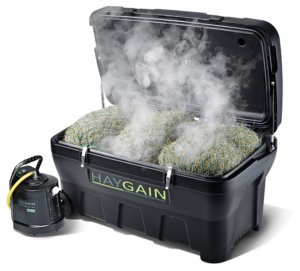Soak Then Steam
A post-soak steam is the healthiest routine for horses on low non-structural carbohydrate diets.
by Kim F Miller
Steaming hay was developed primarily to improve equine respiratory health by removing dust and other inhalable irritants, but the process is gaining popularity for its essential role in treating hay for horses that need reduced non-structural carbohydrates in their diet. To be precise, NSCs are starch plus water-soluble carbohydrates, or WSCs.
Low-NSC diets are called for in conditions that include insulin resistance; Equine Metabolic Syndrome; Equine Pituitary Pars Intermedia Dysfunction, also known as Cushing’s Disease; Polysaccharide Storage Myopathy; laminitis and excess weight. Each condition requires different management. Insulin resistant horses, for example, are typically prescribed a diet that contains less than 12 percent non-structural carbohydrates in their feed.
Although soaking hay is the most effective way to significantly reduce the WSC component of NSC down to safer levels for these horses, confusion surrounds the process because it lacks proven protocols and has downsides many well-intentioned horse owners are not aware of.

Soaking leaches out important nutrients, as well as WSCs, to varying degrees depending on the length of the soak. It also creates an environment in which bacteria and mold, already present in some amount even in the best quality hay, quickly grow. Even just a 10-minute soak has been proven to increase bacteria by a whopping 150 percent. Soaked hay is also just that – soaked hay. It’s wet and a lot of horses don’t like the taste.
So, how can you continue soaking your hay for the horse that needs lower NSC while providing healthy, desirable nutrition? Here’s where hay steaming enters the picture.
Injecting steam into a purpose-built insulated chest, Haygain® Hay Steamers bring the hay inside to at least 212° Fahrenheit, high enough to kill mold, bacteria and spores that survived or increased during soaking. Steaming restores post-soak “diet” hay to a tasty state proven to be preferable to dry and, especially, soaked hay. It’s moist and soft, rather than soggy, and it has an appetite-inducing fragrance that explains why veterinarians love it for getting post-surgery horses back on their recovery meal plan.
Steaming? Soaking? Or Both?
The answer depends on your objectives and on the carb content of the hay, which varies depending on soil and grass type, climate, maturity at harvest and storage method.
Testing to determine the carb content of hay is the critical starting point. If it’s below the generally recommended level of 10% WSC, then you’re in good shape as far as carbs go. If it’s close, steaming may be enough. If not, then research has shown the most effective method to reduce the WCS content is to soak the hay for nine hours first and then steam. This combination of soaking and then steaming will leach four times the amount of WSC compared with single steaming and reduces the bacteria (increased by soaking) by up to 99%.
While many horses thrive on a primarily forage diet, if concentrated feeds are part of your horse’s diet, be sure to include their carb content when calculating your horse’s overall intake.
As far as objectives, if reducing dust, mold, fungi, bacteria and allergens is the primary goal, then steaming is the best option. Extensive Haygain studies at the Royal Agricultural University in Cirencester, England determined that soaking hay dampens down 90 percent of respirable particles, while high-temperature steaming reduces them by 98 percent.
Soaking Can Prompt Bacterial Growth
Both results are substantial, but there’s a huge difference in each method’s impact on bacteria and mold. Soaking for 10 minutes has been shown to increase bacterial content by 150%, and most people soak hay for much longer than that, often overnight for morning feedings or all day for the evening meal. Conversely, Haygain steamers have been shown to reduce all hay pollutants to virtually zero. To be specific: fungi and yeast to zero; viable bacteria by 99 percent; and respirable particles by 98 percent.
If you want to dramatically reduce the NSC level, then soaking is where to start. While steaming does slightly reduce NSC, one of its benefits is that it does not strip important nutrients from hay, so it’s not your stand-alone choice for horses that need low-NSC hay. Research studies determined a 3 percent loss of water-soluble carbs from steaming with Haygain, while soaking showed an average loss of 34 percent. Ongoing research is further substantiating the many variables involved — in the starting carb levels of dry hay and in the carb levels resulting from soaking and steaming. Soil and grass type, climate, maturity at harvest, and storage conditions are among the reasons for these variables.
Steaming after soaking is the ideal one-two punch, assuring hay that’s free of soak-induced bacteria and respiratory irritants, while restoring the hay’s appealing texture and enhancing its fragrance.
Soaking: How-To
Inexact science is one source of confusion surrounding the soaking process. Because hay of different types, regions and harvesting dates has different constitutions, standard protocols for soaking to remove specific quantities of specific nutrients don’t exist.
Dr. Clair Thunes, PhD, an independent equine nutrition consultant with Summit Equine Nutrition, advises clients with horses who need special diets to soak hay for 30 minutes in hot water or 60 minutes in cold. The hay should be fully submerged during that time, then hung to drain for at least 10 minutes before feeding, but not much longer to prevent bacteria growth.
“I tell people to put it in a hay net before soaking, then hang the net above their soaking tub to drain,” she explains. “Often times the hay is going to a metabolic horse who is not getting that much hay in the first place, so the net can be useful for slowing down consumption and stretching out their meal time.”
Be careful with the soaking effluent, Dr. Thunes stresses. It’s tempting to dump the post-soak liquid near the barn. “Hopefully, people are putting that contaminated water into a proper drain so it’s not getting into any streams or other bodies of water.” A 1993 study published in Equine Veterinary Education showed that effluent from 12 hours of soaking hay was 10 times as strong as raw sewage, a big problem for responsible management of stable water run-off.
Know What’s In Your Hay
Another question is how much NSC is removed by soaking. An analysis of post-soaked hay is ideal but not practical for most horse owners, even for those who maintain horses at home stables rather than at public stables. Testing hay for quantities of protein, fibers, carbohydrates, fats and other nutrients is most practical when buying in bulk, but even then the nutrients can change or degrade over time.
If you do have your hay analyzed, make sure the results include the carbohydrates in their various forms. The most important carbohydrate forms for horses with metabolic issues are starch, water-soluble carbs and simple sugars. However, it’s good to know the quantities of other carbohydrate forms: acid detergent fiber, neutral detergent fiber, and non-fiber carbs.
For most people managing horses with special feed needs, following a consistent soaking routine, with hay from the same source and monitoring its impact, is the best way to determine its effectiveness. Closely monitoring your horse is essential, notes Dr. Thunes. “If your horse has a history of laminitis, for example, watch for heat or discomfort in their feet, and check their digital pulse regularly.” There is a reliable pulse source located at the fetlock joint.
Reading the labels on any supplemental feed in your horse’s diet is equally important, Dr. Thunes adds. Soaking to reduce NSC is pointless if the processed feed is loaded with it.
Determining a healthy, special needs diet is a complicated endeavor, best done with the help of a nutritionist or veterinarian. The benefits of steaming hay, however, are a no-brainer, whether soaked or not. After a presentation by a Haygain consulting veterinarian, Dr. Thunes was impressed with the company’s research and the role that respiratory health plays in overall equine well-being. “It really is a limiting factor for horses,” she observes. “You can condition the muscles, heart and the circulatory system, but nothing you do when conditioning them really improves their lung function.”
Hence the importance of protecting the respiratory system, and Haygain steamed hay is the simple solution for that.
Article provided by Haygain. Printing and posting are encouraged. For more information on Haygain, visit www.haygain.com.

Kim F Miller is marketing manager at https://greenhorsebrands.com and a freelance journalist and marketing copywriter. . [email protected].
Bio photo by Sherry Stewart.








